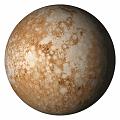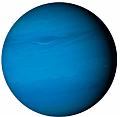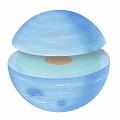Neptune and Beyond
NEPTUNE WAS DISCOVERED AS THE RESULT of calculations. By the early 19th century, astronomers realized that Uranus was not following its expected orbit. The gravitational pull of an unknown planet beyond Uranus seemed the most likely explanation. In 1845, the English mathematician John Couch Adams (1819-1892) announced that he had calculated the probable position of a planet beyond Neptune, but his findings were ignored. In June 1846, the Frenchman Urbain LeVerrier did the same. This time, observers took notice. Johann Galle (1812-1910) of the Berlin Observatory found Neptune on September 23, 1846. Astronomers continued to speculate about another planet beyond Neptune. Pluto was eventually discovered in 1930 and was considered to be the ninth major planet until 2006. Between1992 and 2006, hundreds of small icy bodies had been found beyond Neptune, in what is called the Kuiper belt. They include Eris, which is larger than Pluto. In 2006, astronomers decided to class both Pluto and Eris as dwarf planets. Read some facts about Neptune below, or click here.
Urbain LeVerrier (1811-1877)
LeVerrier was a teacher of chemistry and astronomy at the Ecole Poly technique. Having calculated the position of Neptune, Le Verrier relied on others to do the actual "looking" for the planet for him.
Neptune's Rings
Neptune, like all the giant planets, has a series of rings enCircling it. The rings were discovered when the planet passed in front of a star. Results of an occultation (p.55) in July 1984 showed the typical "blinking on and off,"indicating that Neptune's rings were blocking out the light of the distant star. There seem to be two main rings, with two faint inner rings. The inner ring is less than 9 miles (15 km) wide. The rings were confirmed by Voyager 2 in 1989.
Neptune's Vanishing Great Dark Spot
In 1989 Voyager photographed a great storm system in Neptune's southern hemisphere. The storm, actually a hole in Neptune's upper cloud layer, was about the size of Earth. Smaller clouds at the edges of the hole in this sequence-taken over a four-day period-suggested that the storm rotated counterclockwise. However, in the photographs taken of Neptune by the Hubble Space Telescope in 1995, the storm had disappeared.
The Discovery of Triton
The moon Triton was discovered in 1846. It interests scientists for several reasons. It has a retrograde orbit around Neptune-that is, the moon moves in the opposite direction in which the planet rotates. It is also the coldest object in the solar system, with a temperature of -391°F (-235°C). Triton is a fascinating world. It has a pinkish surface, probably made of methane ice, which has repeatedly melted and refrozen. It has active volcanoes that spew nitrogen gas and darkened methane ice high into the thin atmosphere.
Close Up of Neptune
This picture was taken by Voyager 2 in 1989 after its 12-year voyage through the solar system. It was 3.8 million miles (6 million km) away. Voyager went on to photograph the largest moon, Triton, and to reveal a further six moons orbiting the planet. Neptune has a beautiful, sea-blue atmosphere, composed mainly of hydrogen and a little helium and methane. This covers a huge internal ocean of warm water and gases-appropriate for a planet named after the god of the sea. (Many French astronomers had wanted the new planet to be named "LeVerrier," in honor of its discoverer.) Voyager 2 discovered several storm systems on Neptune, as well as beautiful white clouds high in the atmosphere.
Facts About Neptune
- Sidereal period 163.7 Earth years
- Temperature at cloud tops -346°F (-2J.O°C)
- Rotational period 16 hr 7 min
- Mean distance from theSun 2.795 billion miles/4.495 billion km
- Volume (Earth ~ 1) 57· Mass (Earth ~ 1) 17.14
- Density (water ~ 1) 1.64
- Equatorial diameter 30,775 miles/49.530 km
- Number of satellites 13
Discovering Pluto
Pluto was discovered in 1930 as the result of a systematic search by an Am.erican astronomer, Clyde Tombaugh (1906-1997), working at the Lowell Observatory in Arizona. Its orbit was found to be unusual, being much more elongated than the orbits of the previously known planets. Pluto is sometimes closer to the Sun than Neptune. Gradually, astronomers realized that Pluto was much smaller than they originally thought. It has only one-fifth the mass of our Moon. The first spacecraft ever to be sent to Pluto, New Horizons, was launched in 2006 and will fly by Pluto in 2015.
The Kuiper Belt
In 1951, the Dutch-American astronomer Gerard Kuiper (1905-1973) predicted the existence of a whole belt of small icy worlds beyond Neptune, of which Pluto would be just the first. The next one was not found until 1992, but since then, hundreds have been identified, including Eris in 2005. Some of the smaller ones transform into comets when they stray closer to the Sun. This artist's impression is based on what is known about Eris, which has a small moon called Dysnomia.
Pluto and Charon
The distance between Pluto and its moon, Charon, is only 12,240 miles(19,700 km). Charon was discovered in 1978 by a study of images of Pluto that looked suspiciously elongated. The clear image on the right was taken by the Hubble telescope (p.7), which allows better resolution than anything photographed from Earth (left).
Facts About Pluto
- Sidereal period 248 Earth years
- Temperature -373°P (-225°C)
- Rotational period 6 days 9 hours
- Mean distance from the Sun 3.65 billion miles/5.87 billion km
- Volume (Earth = 1) 0.006
- Mass (Earth = 1) .0022 • Density (Water = 1) 2.03
- Equatorial diameter 1,485 miles/2,390 km
- Number of satellites 3


